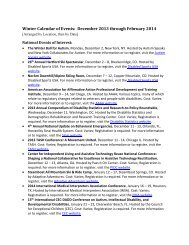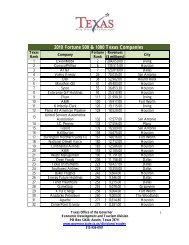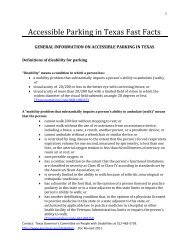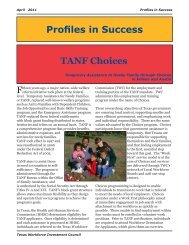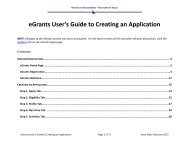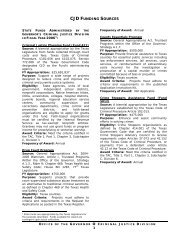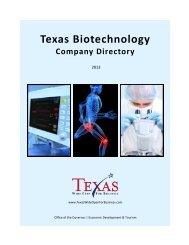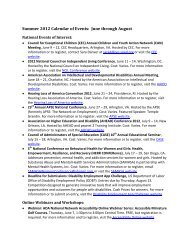People with Disabilities: A Texas Profile
People with Disabilities: A Texas Profile
People with Disabilities: A Texas Profile
You also want an ePaper? Increase the reach of your titles
YUMPU automatically turns print PDFs into web optimized ePapers that Google loves.
Individuals <strong>with</strong> <strong>Disabilities</strong> in the U.S.<br />
According to ACS summary table data used in this section, 12.1 percent of the U.S. civilian<br />
noninstitutionalized population (37,188,115 individuals) had a disability in 2011. Individuals <strong>with</strong><br />
disabilities accounted for 5.9 percent of the civilian labor force 16 years of age and older in 2011. In this<br />
section, a general demographic description of the population of individuals <strong>with</strong> disabilities in the U.S. is<br />
provided as a context for a discussion of the population of individuals <strong>with</strong> disabilities in <strong>Texas</strong> in the<br />
following section.<br />
Population Trends for Individuals <strong>with</strong> <strong>Disabilities</strong> in the U.S.<br />
Illustrating change over time in the number of individuals <strong>with</strong> disabilities in the U.S. is difficult. Because<br />
surveys use dissimilar questions to define disabilities, comparing the numbers of individuals <strong>with</strong><br />
disabilities between different surveys would be misleading. Even comparing the results of the same<br />
survey at two different time periods is complicated since some surveys have revised their disability<br />
questions and administered the questions to different age groups. For example, the 1990 census asked<br />
individuals between the ages of 16 and 64 about work disabilities, mobility limitations, and self‐care<br />
limitations, whereas the 2000 census asked individuals age five and older about work disabilities and<br />
sensory, physical, mental, self‐care, and ambulatory difficulties. Additionally, no questions about<br />
disabilities were asked on the 2010 census since the long form was replaced by the ACS. Results from<br />
the 2008 to 2011 ACS presented in Figure 1 indicate that while the numbers of individuals <strong>with</strong><br />
disabilities have been increasing since 2008, the percentages of individuals <strong>with</strong> disabilities have<br />
consistently comprised approximately 12 percent of the total civilian noninstitutionalized population.<br />
Figure 1: Number of Individuals <strong>with</strong> <strong>Disabilities</strong> in U.S. and Percentage of Population, 2008–2011<br />
37,400,000<br />
37,200,000<br />
37,000,000<br />
36,800,000<br />
36,600,000<br />
36,400,000<br />
36,200,000<br />
36,000,000<br />
35,800,000<br />
35,600,000<br />
35,400,000<br />
12.1% 12.0%<br />
11.9%<br />
12.1%<br />
2008 2009 2010 2011<br />
Figure notes: Data are from ACS summary tables. Percentages represent the portion of the total civilian<br />
noninstitutionalized population <strong>with</strong> disabilities.<br />
<strong>Texas</strong> Workforce Investment Council 7




